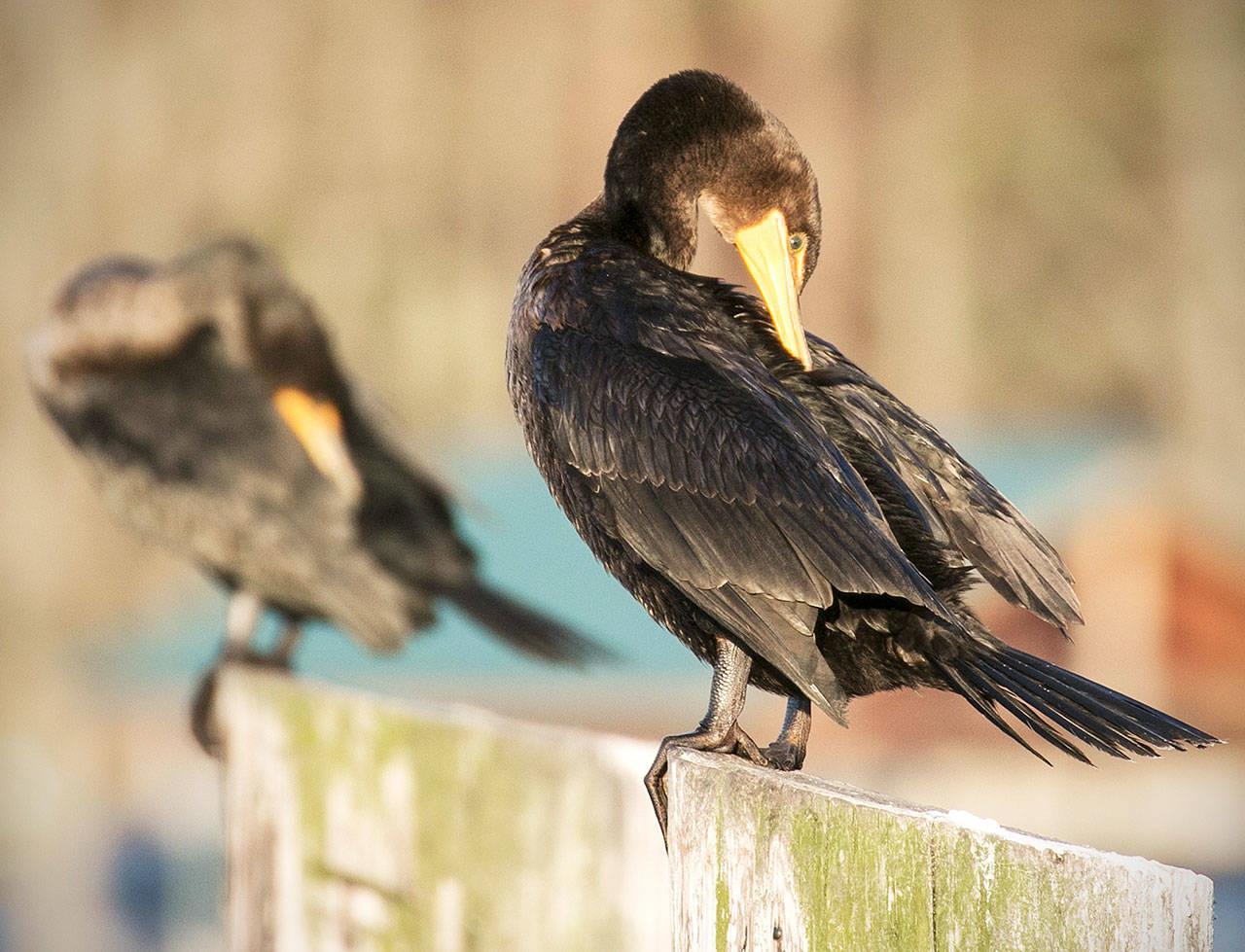I have been watching cormorants at the Anacortes ferry terminal for years, but recently my seat on the ferry was in perfect alignment to see their eggs when a cormorant readjusted its position.
A month or so earlier, two double-crested cormorants were facing off, perhaps for a potential mate, perhaps for a nesting site. Their necks were stretched out and their mouths wide open, showing the bright blue area inside — my blue is brighter than your blue?
Although I couldn’t hear it, there would have been a lot of hissing during the standoff.
From my vantage point, its eggs looked significantly larger than the 2¼- to 3-inch range found in field guides. Perhaps my perspective made a difference.
Males choose the nest site, then try to attract a mate by posturing, wing-waving, vocalizing and zig-zagging across the water, and even splashing the surface with the tips of its wings.
Both sexes build the nest, the male doing most of the stick-fetching, and the female the construction. Sometimes the male will steal sticks from a nearby nest. A little guano helps keep the sticks in place.
Webbed feet propel them underwater after fish, but also serve another purpose. A female cormorant doesn’t have a brood patch on its abdomen. That’s a small area of skin that loses feathers near the end of egg-laying activity. Extra blood vessels form to carry warm blood near the skin to provide heat to the eggs.
Without a brood patch, cormorants cradle the eggs in the webs and cover them with their belly, providing enough warmth all around to do the job.
Cormorants are great divers.
Last year researchers from the Wildlife Conservation Society and the Research Council of Argentina recently attached a small camera on an imperial cormorant. When it dove after a meal, it reached 150 feet underwater in 40 seconds, hunted just off the bottom for 80 seconds, and returned to the surface 40 seconds later.
Cormorants have, comparatively speaking, very little oil to waterproof their feathers. The degree to which feathers are somewhat waterproofed is about feather construction. The structure allows for less buoyancy, thus the ability to dive long and deep after fish. The drawback is that the feathers need to be dried, thus the iconic cormorant wing-spreading pose.
Danish researchers have shown that it can hear under water after testing at a marine biology research station. Its hearing ability is about the same as a seal.
The researchers concluded that hearing underwater would be very useful, perhaps when the water is not clear, or very dark at the bottom. That a cormorant can hear means that sounds from ship traffic might affect them as it has done with porpoises and seals.
Other facts:
• Double-crested cormorants have green eyes; Brandt’s cormorants have blue/turquoise eyes.
• The young are fed fish, although not whole. Adults partially digest the catch and regurgitate it; the chicks reach inside the adult’s throat for a meal.
• A cormorant’s schedule is pretty much feeding and resting, with a little more emphasis on the latter.
• The word “cormorant” comes from the Latin Corvus “marinus,” meaning crow of the sea or sea crow.
• The oldest known double-crested cormorant was at least 22 years old.
• Poet John Milton, in the book “Paradise Lost,” described Satan as having “sat like a cormorant” on the Tree of Life, plotting the downfall of Adam and Eve.
• The U.S. cormorant population was decimated by DDT and PCBs but bounced back — too far back, according to those who say cormorants compete with humans for fish.
• Interesting enough, the dictionary has a second meaning for the word “cormorant”: greedy person.
Columnist Sharon Wootton can be reached at 360-468-3864 or songandword@rockisland.com.
Talk to us
> Give us your news tips.
> Send us a letter to the editor.
> More Herald contact information.

























